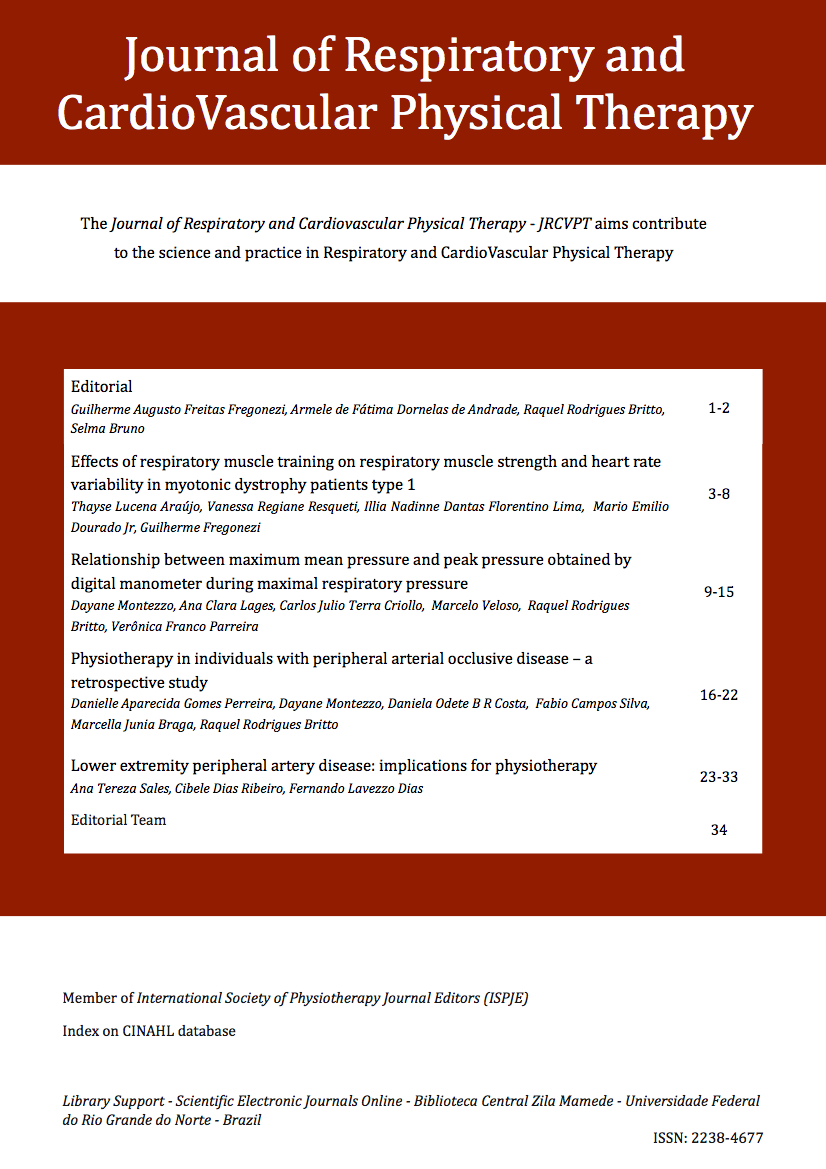Physiotherapy in individuals with peripheral arterial occlusive disease – a retrospective study
Palabras clave:
Physical Therapy Modalities, Peripheral Arterial Disease, Exercise toleranceResumen
Introduction: Treatment for peripheral arterial occlusive disease (PAOD) may consist of intervention procedure, including surgery, and conservative techniques such as rehabilitation. The exercise-based rehabilitation is a viable alternative due to its low cost and effectiveness in functional improvement.
Objective: To evaluate results obtained through physiotherapy for individuals with PAOD in an outpatient program for a minimum of three months.
Methods: Retrospective observational study where data were gathered through a medical chart survey. Functional capacity was assessed using the shuttle walking test and six-minute walk test and functional capacity was evaluated via the Short-Form Health Survey.
Results: Forty medical charts were selected, of which 12 met inclusion criteria. Functional capacity and quality of life measures showed significant improvement. Functional capacity and SF-36 variables were analyzed using the paired t-test.
Conclusion: Twice-weekly supervised treatment displayed favorable results in functional capacity and quality of life measures.
Descargas
Descargas
Publicado
Cómo citar
Número
Sección
Licencia
Copyright Transfer Statement
The author(s) of the article, as specified here, hereby transfer(s) to the Revista de Fisioterapia Respirtória e CardioVascular (Journal of Respiratory and CardioVascular Physical Therapy) all copyright ownership rights, title and interests that the author(s) may have or may come to have in and to the article and any revision or version thereof, including, but not limited to, exclusive right to print, publish and sell the article anywhere in the world, in any language and in any media.
This agreement will be considered effective and valid if and when the article is accepted for publication.
If the article contains any copyright-protected material from a third party, the author(s) must obtain written permission to reproduce the said material in the article from the copyright holder and send it to the Revista de Fisioterapia Respirtória e CardioVascular (Journal of Respiratory and CardioVascular Physical Therapy).
The author(s) guarantee(s) the holding of proprietary rights to the article; not having granted or transferred any rights to the article to any other persons or entity; that the article is susceptible to the demand for rights by its author(s); not having infringed upon any author rights, trademark or patent; not having violated the right to privacy or publicity of any person or entity; that the article does not contain any defaming subject; that the factual statements made are true or are based on reasonably accurate research; and, finally, that, the author(s) has/have no reason to believe that any of the formulas, procedures or prescriptions contained in the article will cause damage if used or followed in accordance with the instructions and warnings contained in the article.
The author(s) will indemnify the Revista de Fisioterapia Respirtória e CardioVascular (Journal of Respiratory and CardioVascular Physical Therapy) against any costs, expenses, damages or liability that the Revista de Fisioterapia Respirtória e CardioVascular (Journal of Respiratory and CardioVascular Physical Therapy) may incur as a result of accidental omissions of these guarantees. These representations and guarantees may be extended to a third party by the Revista de Fisioterapia Respirtória e CardioVascular (Journal of Respiratory and CardioVascular Physical Therapy).
Date:
Note: Each author must individually complete and sign this form
1) Author:
Signature: _________________________________
2) Author:
Signature: _________________________________
3) Author:
Signature: _________________________________
4) Author:
Signature: _________________________________
5) Author:
Signature: _________________________________
6) Author:
Signature: _________________________________
7) Author:
Signature: _________________________________
8) Author:
Signature: _________________________________




 English
English Español (España)
Español (España) Português (Brasil)
Português (Brasil) Français (Canada)
Français (Canada)